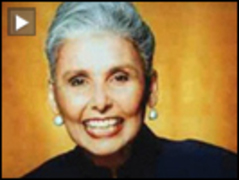
Guests
- Lena Horneinterviewed in 1966 by Pacifica Radio’s Gene DeAlessi at the San Francisco Fairmont Hotel. From the Pacifica Radio Archives
- James Gavinjournalist and author of Stormy Weather: The Life of Lena Horne.
Lena Horne enjoyed a six-decade singing career on stage, television and in film. She was the first black woman to be signed to a long-term contract by a major Hollywood studio. She helped break racial boundaries by acting alongside white entertainers, but she was segregated on screen so producers could clip out her singing when the movies ran in the South. In the 1950s, she was blacklisted in part because of her friendship with Paul Robeson and W.E.B. Du Bois. In 1963, Lena Horne took part in the March on Washington alongside Harry Belafonte and Dick Gregory and was part of a group, which included authors James Baldwin and Lorraine Hansberry, that met with Attorney General Robert F. Kennedy to urge a more active approach to desegregation. We air a rare 1966 interview with Lena Horne from the Pacifica Radio Archives and speak to her biographer, James Gavin. [includes rush transcript]
Transcript
SHARIF ABDEL KOUDDOUS: We end today’s show by paying tribute to the life and legacy of pioneering singer and actress Lena Horne. She died on Monday at the age of ninety-two.
Lena Horne enjoyed a six-decade singing career on stage, television and in film. She was the first black woman to be signed to a long-term contract by a major Hollywood studio. She helped break racial boundaries by acting alongside white entertainers such as Gene Kelly and Mickey Rooney, but she was segregated on screen so producers could clip out her singing when the movies ran in the South.
In the late 1940s, she defied segregation policies at upscale hotels in Miami Beach and Las Vegas by insisting that she and her musicians be allowed to stay wherever they entertained. In the 1950s, she was blacklisted in part because of her friendship with Paul Robeson and W.E.B. Du Bois.
AMY GOODMAN: In 1963, Lena Horne took part in the March on Washington alongside Harry Belafonte and Dick Gregory. She was part of a group, which included authors James Baldwin and Lorraine Hansberry, that met with Attorney General Robert F. Kennedy to urge a more active approach to desegregation.
Before we’re joined by Lena Horne’s biographer, we turn to Lena Horne in her own words. This is from the Pacifica Radio Archives, an interview Lena Horne did with Pacifica Radio in 1966. She was interviewed by Gene DeAlessi at the San Francisco Fairmont Hotel. He asked her to talk about her father.
LENA HORNE: My father was a Negro man who, to survive, hustled. And in this sense of hustling and a Negro man, it means that oftentimes if you are educated and able to get a job, the most menial — and that was all you had the opportunity to — a job you had to hold — you didn’t want to do that. And you didn’t want to work for someone who had less talent, less brains, than you. So you risked your life; you laid your life down on the line. You were a hustler. You worked with, in many times, criminal attitudes. It took a lot of guts. And on the one hand, you chose that, rather than have “The Man” make a slave out of you.
GENE DEALESSI: Who is “The Man”?
LENA HORNE: I knew as soon as I said that, I shouldn’t have, without explaining it. The Man is the employer. And The Man, who was unusually the employer that offered the Negro man either the right to be a hustler or work for him, was usually a white man, a white employer.
GENE DEALESSI: And this spring-like day in 1966, that patois, The Man —-
LENA HORNE: Yes.
GENE DEALESSI: —- continues.
LENA HORNE: Still continues, of course. The Man is a sheriff in Mississippi. The Man is a cop in Harlem, white.
GENE DEALESSI: Could he be Negro?
LENA HORNE: He could be Negro, because even though he’s Negro, The Man who’s the head of his police department is the white man.
AMY GOODMAN: Lena Horne speaking in 1966, interviewed by Pacifica Radio’s Gene DeAlessi, that courtesy of the Pacifica Radio Archives.
For more on Lena Horne’s life and legacy, we’re joined by James Gavin, a journalist and author — his book is Stormy Weather: The Life of Lena Horne — joining us from Los Angeles.
Welcome to Democracy Now!, James. Start by responding to this remarkable clip of Lena Horne in 1966, and put it in the context of her life, a thumbnail sketch of where she was born, how she grew up and became the singer and actress that she was.
JAMES GAVIN: Well, 1966, the civil rights movement was still white hot, so to speak, and Lena Horne was desperate to find her way within it, even though she came from a history of activists and poets and teachers and intellectuals — that was who her family was — as part of the so-called black bourgeoisie, a very small minority of highly educated, upwardly mobile, cultivated black people around the early part of the century. And Lena Horne came from that intellectual tradition, and she was raised with a fierce sense of social responsibility, enrolled in the NAACP at the age of two. Can you imagine what kind of a mantle that is to carry?
And throughout her entire show business career, there was much more for her to worry about than doing a good job. She was a symbol. And that is some pressure to carry through life. In 1966, though, she had just about found a little foothold for herself in the civil rights movement and gotten some people to take her seriously as more than an ex-Hollywood star, a kind of pampered creature of white show business, which is how a lot of people perceived her then.
SHARIF ABDEL KOUDDOUS: And she was the first African American woman to sign a meaningful long-term contract with a major studio. But in the contract it said she would never have to play a maid. And in her autobiography, she wrote, “They didn’t make me into a maid, but they didn’t make me anything else, either. I became a butterfly pinned to a column, singing away in Movieland.”
JAMES GAVIN: A lot of that is exaggerated, I have to tell you. It’s true that the reason for Lena Horne being at MGM, which signed her in 1942, was that she was a sort of a pawn, as she put it, of the NAACP. The great NAACP leader Walter White saw Lena Horne as a tool for revolutionizing the black image in Hollywood. She was beautiful in a way that white America could accept. There was no such thing in 1942 as the phrase “black is beautiful.” Lena Horne was beautiful in a more Hedy Lamarr, Rita Hayworth style, very refined ways, a Caucasian singing style, Caucasian in a lot of her manner.
And as for the butterfly pinned to a column remark, which became part of her myth, it’s a famous phrase, but there’s not a single scene of Lena Horne in any of her films that show her standing next to a column. Lena felt imprisoned because she was not really allowed to interact with white actors on screen. She was presented in these beautifully produced cameo segments by MGM, but she wanted much more.
AMY GOODMAN: Let’s turn back to Lena Horne speaking on Pacifica Radio in 1966. Again, the interviewer Gene DeAlessi asking Lena Horne to talk about her relationship with Paul Robeson.
LENA HORNE: Paul taught me about being proud because I was Negro. I had always had this pride, this fierce, sterile, almost, kind of pride, because my grandmother had said, “You must be proud.” But she never told me all the horror of her background. One didn’t talk about it, you see. And then she died. And I was getting more and more in that middle-class trap with Negroes who might have a job, who didn’t speak about it also. I worked even at the time I was sixteen and with Sissle, with organizations, but he never told me the reasons why I had a right to some of that pride, you see.
But Paul is the first one who came to me and said, “Your grandmother was a fiery little woman who chased me off the street corners of Harlem.” And she was this, and she was that. I said, “Really? Nobody ever told me that.” He said, “Why, she was a wonderful Negro woman, because she wanted to help her people, and she felt she had a right to it. And she made this expression, noblesse oblige, mean being proud of her people.” And I said, “But nobody ever said it.”
And he sat down for hours, and he told me about Negro people and what — you know, I’ve read it in some books and never learned it in school; they don’t teach it in history books. I couldn’t know anything unless I really had moved up by then from the South and had been with Negro people who were terrified, you know, and couldn’t do anything about it. And he didn’t talk to me as a symbol of a pretty Negro chick singing in a club. He talked to me about my heritage. And that’s why I was always loved him. And I didn’t even know — he didn’t even speak to me as a leader, quote “Negro leader.”
And so, I grew to think then about all the — all the areas of it. And Josh taught me about singing about it. And I couldn’t sing, you know. And I was fighting that kind of inverse chauvinism from white people who said, “Ah, she can’t sing the blues,” you know. And so I felt embarrassed. But, by 1966, I find more and more myself calling upon the things that Paul said to me, because it’s as of now, except he is not our leader. We eat up our leaders, you know. We — history eats our leaders up. We eat them up. We drain them. And we throw them out because everything moves so fast. But I don’t think I could have felt the kind of pain I did and the kind of sense of recognition, when I saw Alabama and hoses and dogs and children, if I hadn’t had Paul in my life.
AMY GOODMAN: Lena Horne, talking about Paul Robeson. James Gavin, take it from there and also talk about her relationship with W.E.B. Du Bois and with Harry Belafonte.
JAMES GAVIN: Oh, that’s a lot. My goodness. Her relationship with Paul Robeson ended up getting her in big trouble, because, as you know, Paul Robeson was a dangerous man in the 1940s. And then in the late ’40s, when he became a vocal enthusiast of the Soviet Union, to be near Paul Robeson in that brewing McCarthy era was very dangerous. Lena Horne was heavily involved in the 1940s with all of these human rights progressive groups that were burgeoning all over Los Angeles, New York City. And she ended up blacklisted in 1950 in red channels.
Now, she was, by that time, out of MGM, none too happily, and was a nightclub singer. So the blacklist didn’t really affect her very much. But certainly, she met Harry Belafonte in those years, and Harry Belafonte was another fierce spokesman, deeply committed to human rights. Mr. Du Bois, we know about. He was really the grandfather of them all in those days.
Lena Horne was a very brave woman and is not given credit for the activism that she did in the 1940s, at a time when a lot of the black performers that she knew were simply accepting the conditions of the day as the way things were and were afraid of rocking the boat and losing their jobs. And Lena never hesitated to speak her mind.
AMY GOODMAN: W.E.B. Du Bois?
JAMES GAVIN: Oh, a comment on W.E.B. Du Bois?
AMY GOODMAN: Yes.
JAMES GAVIN: She didn’t — you know, he was more a friend of her grandmother’s than Lena. He is — generationally speaking, he came before Lena. And I know that she met him, but I don’t think that she was a close friend of his. Her true mentors in the 1940s, politically speaking, were Robeson and Eleanor Roosevelt. Lena Horne adored Eleanor Roosevelt. And anything that these two people told her that they should sign or be a part of, she did.
AMY GOODMAN: And Harry Belafonte, long relationship with him, both political and artistic.
JAMES GAVIN: Long love/hate relationship that lasted, on and off, for about thirty years. And then, by the early 1980s, these two strong egos finally exploded and clashed for the last time. But she and Harry were both beauties who suffered, I think, a similar identity crisis, in that their audiences were primarily white America, even upscale white America. And I think that both of them, for many years, had a big struggle in terms of how to define themselves as black artists. Harry, though, my god, I’ve got to admire that guy for the risky political stands that he took throughout his life.
AMY GOODMAN: We’re going to leave it there and then do a web exclusive, for people to go to our website at democracynow.org to continue this conversation. James Gavin is the biographer of Lena Horne, his book, Stormy Weather: The Life of Lena Horne.












Media Options